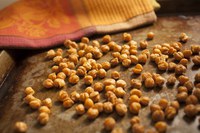Prairie Fare: Add Some Pulse Foods to Your Menu
(Click an image below to view a high-resolution image that can be downloaded)
By Julie Garden-Robinson, Food and Nutrition Specialist
NDSU Extension
“Pease porridge hot, pease porridge cold, pease porridge in the pot …”
If you are familiar with this old English children’s nursery rhyme, you might recall that it ends with “nine days old.”
According to some historical references, people in Medieval times would keep a pot of a stewlike recipe simmering in a big kettle suspended over an open fire. Each day, the pot would be “fed” with kitchen scraps.
Of course, keeping a pot simmering for nine days does not meet modern food safety standards. Be sure to use leftovers in your refrigerator within four days.
Other food writers have said that in times of scarcity, incorporating leftovers from the evening meal as the breakfast was more likely than the primitive slow cooker hanging over a fire.
Some type of pulse likely was a key ingredient in these early porridge recipes. In fact, the word “pulse” comes from the Latin word “pulsis,” meaning “porridge.”
According to the Food and Agriculture Organization (FAO), the broad pulse food category is part of the “legume” family. Worldwide, pulses include dry edible beans, chickpeas, lentils and split peas.
Food historians have indicated that pulses have been used at least 11,000 years in cuisine throughout the world. Lentils are referenced several times in the Bible. The first cookbook from about 900 A.D. includes a lentil soup recipe. Lentils have been found in Egyptian tombs.
From an agronomic standpoint, pulses nourish the soil with their ability to “fix” nitrogen. People began eating rice with beans because the two foods “complement” each other. One food provides the protein-building blocks (amino acids) the other food lacks. Complementary proteins allowed people to have a balanced diet when meat was scarce or when vegetarian diets were followed.
We grow pulses in abundance in the Midwestern U.S. and other states. Pulses were so important in nourishing the world that 2016 was deemed “The International Year of the Pulse.”
Hummus is one of the “stars” in the pulse world, with sales projections expected to reach nearly $1 billion by 2026. Hummus has been used widely in traditional Middle Eastern cuisine. Hummus usually is made by processing chickpeas (also called garbanzo beans) with tahini and garlic, but it also can use other beans as the basis.
Even though pulses are an ancient crop, we are beginning to discover their potential as whole foods and as ingredients in other foods.
Pulses are notably rich in protein, fiber and many vitamins and minerals. In fact, pulse-based protein often is used in meat analogs such as plant-based burgers.
You might associate the word “pulse” with the thump, thump, thump of your heart beat. Eating more pulse foods actually is good for your heart with their combination of nutrients.
Researchers have shown that eating more pulse foods may decrease our risk for certain types of cancer because of the natural antioxidants and other components. Eating pulse foods may help with blood sugar management among those with diabetes.
Adding pulse foods to your diet may help with weight management and might improve digestion. Eating more protein and fiber helps us feel full longer, so we might consume fewer calories.
However, when you increase your fiber, be sure to increase the amount of fluids in your diet to avoid digestive upset.
Are pulse foods on your menu? Pulse foods can be used in a wide range of ways, including appetizers, salads, soups, main dishes and desserts. Visit https://www.ag.ndsu.edu/fieldtofork/choose-your-crop and click on “chickpeas” or “dry beans” for numerous recipes and more nutrition information. You will find several savory and even dessert-style hummus recipes, by the way.
Pulses do not contain typical allergens found in wheat, nuts, dairy, soy and other foods. If you want to enjoy a food with a crunchy texture, try making roasted chickpeas to top salads or to enjoy as a snack on the go. See https://www.ag.ndsu.edu/food/videos/roasted-chickpeas-cajun to view a video about roasting chickpeas.
Roasted Italian Chickpeas
1 (15-oz.) can chickpeas, drained and rinsed
2 Tbsp. olive oil (or your favorite cooking oil)
1/2 tsp. kosher salt
1/2 tsp. oregano
1/2 tsp. garlic powder
1/2 tsp. crushed red pepper
Preheat oven to 350 F. Line baking sheet with aluminum foil for easy cleanup. Drain and rinse chickpeas and then pat dry with a paper towel. Discard any excess skins that fall off in the washing. In a medium bowl, mix together chickpeas, olive oil, salt, oregano, garlic powder and crushed red pepper. Spread chickpeas evenly onto a baking sheet. Bake for about 50 to 60 minutes or until the chickpeas reach a desired crunch. Check and move/stir the chickpeas every 10 minutes. Remove from oven and cool completely. Serve.
Makes 10 servings (2 Tbsp. each). Each serving has 80 calories, 3.5 grams (g) fat, 3 g protein, 9 g carbohydrate, 0 g fiber and 200 milligrams sodium.
(Julie Garden-Robinson, Ph.D., R.D., L.R.D., is a North Dakota State University Extension food and nutrition specialist and professor in the Department of Health, Nutrition and Exercise Sciences. Follow her on Twitter @jgardenrobinson)
NDSU Agriculture Communication - June 17, 2021
Source: Julie Garden-Robinson, 701-231-7187, julie.garden-robinson@ndsu.edu
Editor: Ellen Crawford, 701-231-5391, ellen.crawford@ndsu.edu




